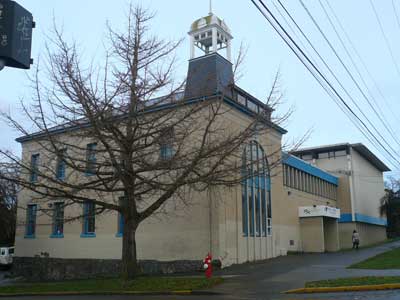Heritage Register
Fernwood
1240 Yates Street
Number 2 Fire Hall
Built
1899; 1910
Heritage-Designated 2004/Institutional
For: City of Victoria
Architect: Thomas C. Sorby
Contractors: George Snider (1899);
Parfitt Brothers (1910)

ARCHITECTURE:
No. 2 Fire Hall on Yates St is one of the oldest Fire Stations to survive in Victoria, along with the rear of City Hall, #1 Centennial Sq, and the Deluge Fire Station at 636 Yates St. No.2 Fire Hall is built of red brick on a rubble-stone foundation, originally parged, and has a decorative dentilated brick cornice. The building dominates the intersection of Yates and Camosun, and is itself dominated by the bell tower, though the bell is gone. The tower has a tapered base with the original slate cladding, an ogee-shaped roof with a lunette on each side, and open-work timbers set on an angle. The main roof is shallow, hipped and covered with original slate, with a galvanized ridge. There is a shallow hip-roofed dormer on the front with multi-light windows, and a finial supporting a flagpole.
The upper floor of the main two-storey building originally had a Romanesque arch sheltering a recessed balcony. The lower level had a wider arch over the main entry. Both arches had keystones. Major renovations undertaken by Parfitt Bros in 1910 involved dividing the original single fire door into two sets of doorways. All evidence of that was erased when the City renovated the building in the 1970s, converting it to a Boys Club facility. The “18 FIRE HALL 99” sign in the frieze was removed. The Romanesque arch still exists, but has been filled in with five tall windows separated by pilasters. Though a long extension has been added on the right side of the building, the left façade, facing Camosun St, remains mostly intact, with nine windows.
ORIGINAL OCCUPANTS:
“It was not until just before the turn of the century that construction of new fire halls at last got underway in Victoria. This process of renewal was begun with the building of the city’s first fully up-to-date “outside” (other than headquarters) hall.One of the areas of Victoria most urgently needing protection was the upper end of Yates Street, some seven blocks east of city centre. Considerable residential development had recently taken place and there was only very rudimentary fire protection in the form of volunteers at the Central School. It took nine years of discussions for residents to convince the City Council that professional firefighters permanently stationed there were needed.”*
Council approved the motion to build on January 23rd, 1899, and three days later City Building Inspector William W. Northcott advertised a tender call: “Competitive Plans, with Specifications will be received [by] February 13th, next, for a proposed new fire hall, to be built on the corner of Yates and Camosan (sic) streets, for the corporation of the city of Victoria.The cost of the building is not to exceed $3,200.” (VDC 26 Jan1899 pg5) On 21st February it was announced that the fire wardens had approved the plans by architect T.C. Sorby. Contractor George Snider won the construction contract with his bid for $3,154; it was the lowest of 16 bids, the others submitted by many of Victoria’s best known contractors. Snider began construction on 27th March. Just four months later, the Colonist reported that the new fire hall would soon be occupied by “two permanent firemen, equipped with a combination chemical engine and hose wagon and two horses, affording the protection from fire so long sought for by residents in the locality east of Cook street. Electricity will be used for lighting purposes at night. The upper storey will be used for sleeping apartments, with a bathroom adjoining. Standing ten feet from the line of sidewalks, and occupying a prominent position on the hill, it is expected that quick time will be made in every direction.” VDC, 13 July 1899, p.6.
“Standard practice was to build fire halls whenever possible on ground higher than the area they were to protect. The reason was simple: if a team of horses had to begin its run to a fire towing heavy apparatus uphill, the animals tired very quickly – obviously a serious problem in a situation where speed was essential. Horse-drawn apparatus in any case had a very short range of probably one to one and one half miles when the team ran at a full gallop. The apparatus floor of No.2. Hall was designed to accommodate the horses and reduce response time. The horses’ stalls were situated beside the apparatus and these were equipped with doors that were opened automatically when an alarm came in.”*
OTHER OCCUPANTS:
The closing of No.2 Hall in 1952 was very contentious, as a number of firemen were let go. About five years later the City built a new hall on the opposite corner at 1234 Yates St and included a large windowed area for display of historic fire fighting apparatus. In 1966 the City entered into a 99 year lease with the Boys & Girls Club of Victoria, who use the original hall as a recreational facility; the lease requires the Club to repair and maintain the building, excepting reasonable wear and tear. In 2004, when it was discovered that the cupola tower was in a dangerous condition, Council approved the expenditure of approximately $18,200 from the City’s Building Maintenance fund. The City also at that time designated the 1899 fire hall portion of the structure.
*excerpted with author’s permission from Dave Parker, First Water Tigers: A History of the Victoria Fire Department, Victoria, Sono Nis Press, 1987. Second Edition, expanded, Dave Parker, First Water Tigers! The Victoria Fire Department: 1858-2008, Victoria Fire Department Historical Society, Victoria, BC, 2008.
ADDITIONAL INFORMATION & IMAGES:
• Fernwood History
• Fernwood Heritage Register
• This Old House, Victoria's Heritage Neighbourhoods,
Volume One: Fernwood & Victoria West

